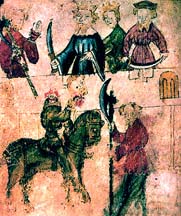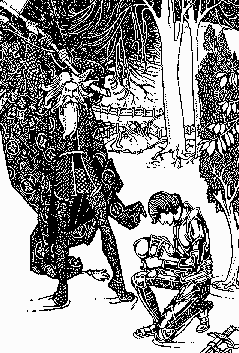
Even though little is known about the author of Sir Gawain and the Green Knight, it is considered to be one of the greatest romances of all time. The poem tells the story of one of Arthur's noblest and most courageous knights, Sir Gawain, who is in search of the Green Chapel: "Sir Gawain ingeniously combines two plots, common in folklore and romance, although not found together elsewhere: the beheading contest, in which two parties agree to an exchange of blows with a sword or an ax, and the temptation, an attempted seduction of the hero by a lady" (Norton 200). The poem Sir Gawain and the Green Knight deals with important themes and ideas such as nobleness, chivalry, knighthood, Christian ideals, truth, temptation, and hunting among others. The poem is also a "study [of] how successfully Gawain, as a man wholly dedicated to Christian ideals, maintains those ideals when he is subjected to unusual pressures" (Norton 200). The poet effectively uses literary devices such as alliteration, rhyme, irony, metaphor, symbolism, and imagery to reinforce his ideas and themes.
This passage of Sir Gawain and the Green Knight deals with Gawain's encounter with the Green Knight in the Green Chapel. The guide describes the Green Knight as a big, cruel, scary monster. He tells Gawain that because of his cruelty, no one wants to get in the vicinity of the Green Knight. He warns Gawain to not risk his life by going to the Green Chapel, and promises him that he will conceal everything. However, Gawain must face the Green Knight and face the hit, because he is noble, worthy, and courageous. He is not a coward. He says to the guide, "But though you never told the tale, if I turned back now, forsook this place for fear, and fled as you say, I were a caitiff coward; I could not be excused" (2129-2131). This is another test of Gawain's character.
The guide leaves and Gawain proceeds further. He has accepted the belt in hope that it will save his life, but incase it doesn't, Gawain has now put himself in god's hands. Gawain rides up the hill in the wild evil landscape. He realizes that the barrow is the Green Chapel. Upon seeing the evil landscape and the Green Chapel, he thinks that it is a chapel of mischance and the devil might live there. As he proceeds further, he hears the noise of the sharpening of an ax. Here the ax represents success. The noise becomes unbearable and Gawain calls out for the Green Knight. The Green Knight appears, but there is a river between him and Gawain. The Green Knight uses the ax as a vaulting tool to get over the river to the other bank where Gawain now is.

Gawain has promised to accept a hit, and so he bows his head down and bares his neck to receive the hit. Even though Gawain bares his neck to receive the hit, he is extremely cautious and fully aware of the Green knight's strength and the fact that he could be dead with just one stroke of the ax. The Green Knight raises his ax, but just as the blade gets close to his neck, Gawain flinches. Upon seeing this the Green Knight begins to taunt Gawain. He says:
Gawain tells the Green Knight that the next time he will neither flinch nor flee and asks him to strike him once more. He tells the Green Knight that he is a mortal and therefore, if he dies there is no way to bring him back. He is not supernatural like the Green Knight. He says. "But if my head falls to the floor There is no mending me!" (2283-2284).
The second time the Green Knight again lifts his ax, but this time he does not hit Gawain. He praises Gawain for not flinching this time. The Green Knight is amused by the whole situation. Gawain again asks the Green Knight to strike him, but this time the Green Knight only scratches his neck. Upon seeing his blood on the snow, Gawain puts up his shield in defense. Gawain has kept up his promise, and does not need to take another hit from the Green Knight.
The Green Knight then tells Gawain the truth of his identity. He tells Gawain that he did not hit him the first two times, because the first two times Gawain was honest and kept his end of the bargain in the pact. The pact is that the host and Gawain will exchange with each other all the winnings of the day. Gawain will exchange his winnings at the castle with the host's winnings at the hunting trip. The first two times Gawain keeps his end of the bargain and truthfully exchanges his winnings with the host. The Green Knight tells Gawain that he taps his neck the third time, because the third time Gawain did not keep up his end of the bargain in the pact. The third time Gawain does not exchange all his winnings with the host. He conceals the green belt, which is given to him by the lady, from the host. This is where he fails. The Green Knight says to Gawain:
The Green Knight tells Gawain that he is really the host, Bercilak de Hautdesert, and it is his belt that Gawain is wearing. The host tells Gawain that he put his wife up to it and asked her to seduce him; it was all a test of Gawain's character. Gawain has the reputation of being the most courteous, worthy, noble, and polite of Arthur's knights. In this poem the three literal hunts of the deer, boar, and the fox are paralleled with the three figurative hunts--the attempted seduction of Gawain by the lady. The lady's attempted seduction of Gawain three times is really a test of Gawain's character. Gawain passes the test two times by keeping the pact, but the third time he fails the test by concealing the green belt from the host. The pentangle represents Gawain's commitment to the truth, and that is where he fails. The green belt represents sin and frailty of human nature. Gawain's failure proves that he too is human and not without faults. However, as the Green Knight says, "the cause [of Gawain's failure] was not cunning, nor courtship either, But that [he] loved [his] own life; the less to blame" (3267-3268). Gawain keeps the belt, because he believes that it will save his life. Gawain thought he was perfect, but now he finds out that he too has faults and is not so perfect after all. Gawain is horribly embarrassed, because he was afraid and took the belt, and he takes off the belt. He says:
However, the Green Knight still holds Gawain to be as "free of fault" as before, because Gawain realizes and is sorrowful about his mistake (2398). The host gives him the belt as a token, so that he remembers the adventure he had at the Green Chapel. Gawain keeps the belt as a reminder of his faults.
In conclusion, although the poem Sir Gawain and the Green Knight was written by an unknown author, it is an excellent work that tells the story of Sir Gawain, who is in search of the Green Chapel. In his quest for the Green Chapel, Sir Gawain goes through many tests of character. "Truth is the quality, even more than martial courage, that is put to the test in Gawain's quest to seek out the Green Chapel...It is also tested, however in the bedroom of a magical castle in the wilderness in ways that are by no means obvious to the hero--or the reader--until the final encounter with the Green Knight" (Norton 201). Gawain's fails the test by lying to the host and concealing the green belt. However, Gawain does this only because he believes the green belt has magical protection and can save his life. Gawain's failure shows that he too is human and has faults.
This page was created by Vinisha Bhatia